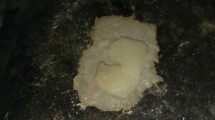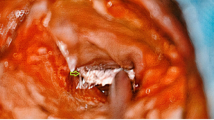Abstract
(1) To compare graft take up of type-1 tympanoplasty with cartilage palisade technique with those of type-1 tympanoplasty using autotemporalis fascia. (2) To compare hearing results of type 1 tympanoplasty with cartilage palisade technique with those of type-1 tympanoplasty using autotemporalis fascia. A prospective clinical study. It consisted of 60 patients divided into two groups of 30 patients each. After randomization 30 patients underwent type 1 tympanoplasty using cartilage palisade technique and 30 underwent type 1 tympanoplasty using autotemporalis fascia. In follow up, pure tone audiogram were carried out at 2nd, 4th and 6th month. Clinical assessment was done at 2nd 4th and 6th month. The graft uptake rate between the group 1 and group 2 are 93.33 and 90% respectively. As p value was greater than 0.05 so statistically there is no significant difference between the two group. The post operative air bone gap of the two groups were compared using student t test. The pre op mean of group 1 was 32.5 db and pre op mean of group 2 was 30.66 db. The post op mean of group 1 was 21.33, with standard deviation of 3.6984 and standard error of 0.67523. The post op mean of group 2 was 21.09 with standard deviation of 3.29 and standard error of 0.58261. t value was 0.1357. Analysis was done using student t test and p value was found to be greater than 0.05. p value is greater than 0.05 which shows that there is no statistical difference between the two groups. This study establishes the fact that hearing results after performing type 1 tympanoplasty by autotemporalis fascia when compared with type 1 tympanoplasty performed by cartilage palisade technique showed similar hearing gain and post operatively graft take up rate was also similar in two groups. The disadvantage of reducing the mechanical vibration of the tympanic membrane was overcome by the palisade reconstruction of the tympanic membrane. This study definitely emphasizes upon usage of new grafting materials in reconstruction of tympanic membrane, with similar, if not better functional results, without compromising the acoustic transfer characteristics.




Similar content being viewed by others
References
Adkins WY, White B (1984) Type 1 tympanoplasty: influencing factors. Laryngoscope 94(7):916–918
Murbe D, Zahnert T, Bornitz M, Huttenbrink KB (2002) Acoustic properties of different cartilage reconstruction techniques of the tympanic membrane. Laryngoscope 112(10):1769–1776
Neumann A (1999) The Heermann “cartilage palisade tympanoplasty”. HNO 47(12):1074–1088
Kazikdas KC, Onal K, Boyraz I, Karabulut E et al (2007) Palisade cartilage tympanoplasty for management of subtotal perforations. Eur Arch Otorhinolaryngol 264:985–989
Amedee RG, Mann WJ, Riechelmann H (1989) Cartilage palisade tympanoplasty. Am J Otol 10:447–450
Duckert LG, Mueller J, Makielski KH, Helms J (1995) Composite autograft “shield” reconstruction of remnant tympanic membranes. Am J Otol 16:21–26
Dornhoffer JL (2006) Cartilage tympanoplasty. Otolaryngol Clin N Am 39:1161–1176
Gerber MJ, Mason JC, Lambert PR (2000) Hearing results after primary cartilage tympanoplasty. Laryngoscope 110:1994–1999
Neumann A, Kevenhouster K, Gostian AO (2010) Long term results of palisade cartilage tympanoplasty. Otoneurotol 31:936–939
Gerber MJ, Mason JC, Lambert PR (2000) Hearing results after primary cartilage tympanoplasty. Laryngoscope 110:1994–1999
Beutner D, Huttenbrink KB, Stumpf R et al (2009) Cartilage plate tympanoplasty. Otoneurotol 31:105–110
Poe DS, Gadre AK (1993) Cartilage tympanoplasty for the management of retraction pockets and cholesteatoma. Laryngoscope 103:614–618
Uzun C, Caye-Thomasen P, Andersen J, Tos M (2003) A tympanometric comparison of Tympanoplasty with cartilage palisades or fascia after surgery for tensa cholesteatoma in children. Laryngoscope 113:1751–1757
Yetiser S, Hidir Y (2009) Temporalis fascia and cartilage-perichondrium composite shield grafts for reconstruction of the tympanic membrane. Ann Otol Rhinol Laryngol 118(8):570–574
Author information
Authors and Affiliations
Corresponding author
Rights and permissions
About this article
Cite this article
Arora, N., Passey, J.C., Agarwal, A.K. et al. Type 1 Tympanoplasty by Cartilage Palisade and Temporalis Fascia Technique: A Comparison. Indian J Otolaryngol Head Neck Surg 69, 380–384 (2017). https://doi.org/10.1007/s12070-017-1137-y
Received:
Accepted:
Published:
Issue Date:
DOI: https://doi.org/10.1007/s12070-017-1137-y




